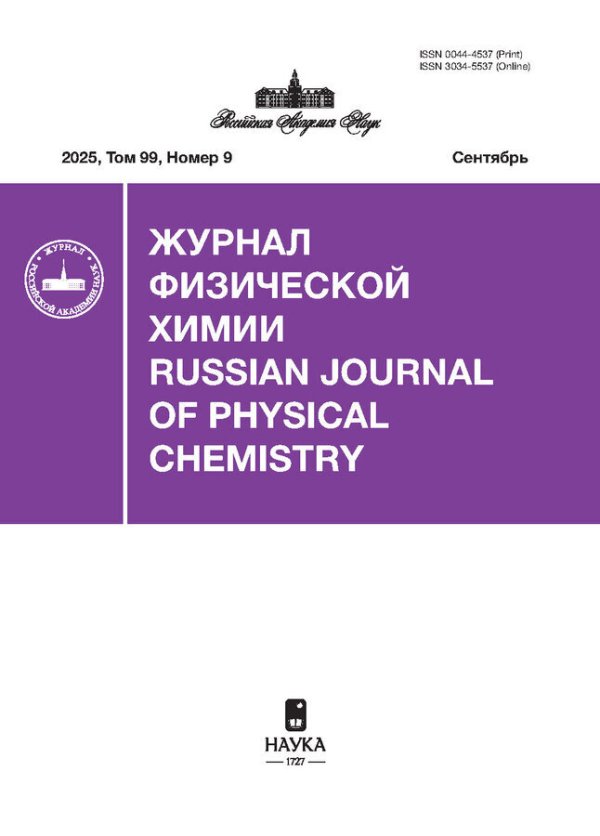Механизм формирования наноразмерных оксидов в среде сверхкритического флюида СО2
- Авторы: Голубев Д.В.1, Сигов А.С.1, Колобанов А.И.1, Фомичев В.В.1
-
Учреждения:
- МИРЭА – Российский технологический университет
- Выпуск: Том 97, № 7 (2023)
- Страницы: 1038-1044
- Раздел: ФИЗИЧЕСКАЯ ХИМИЯ НАНОКЛАСТЕРОВ, СУПРАМОЛЕКУЛЯРНЫХ СТРУКТУР И НАНОМАТЕРИАЛОВ
- Статья получена: 15.10.2023
- Статья опубликована: 01.07.2023
- URL: https://journals.rcsi.science/0044-4537/article/view/136638
- DOI: https://doi.org/10.31857/S0044453723070117
- EDN: https://elibrary.ru/SKRHQM
- ID: 136638
Цитировать
Полный текст
Аннотация
Рассмотрен возможный механизм формирования наноразмерных оксидов в среде сверхкритического флюида СО2 исходя из изопропоксидов титана и алюминия. Показано, что сверхкритический флюид в силу межмолекулярных взаимодействий и высокого давления в системе приобретает свойства конденсированной среды, главная роль которой состоит в “сдерживании” процессов гидролиза. На первом этапе гидролиза изопропоксида титана, молекула воды координируется во внешней сфере центрального атома за счет образования межмолекулярных водородных связей, затем следует координация ее во внутреннюю сферу с образованием пятикоординационного переходного состояния и его разрушение с образованием замещенного на гидроксо-группу продукта. Дальнейшие стадии протекают аналогично. Описанный механизм согласуется с экспериментом и приводит к образованию наноразмерного рентгеноаморфного оксида титана, в то время как в случае изопропоксида алюминия, может быть, образуется только гидролизованная гидроксо-форма. Полученные результаты позволяют предполагать, что получение наноразмерных оксидов исходя из изопропоксидов в среде сверхкритического флюида СО2 возможно для переходных d-элементов.
Об авторах
Д. В. Голубев
МИРЭА – Российский технологический университет
Email: valeryfom@rambler.ru
Россия, Москва
А. С. Сигов
МИРЭА – Российский технологический университет
Email: valeryfom@rambler.ru
Россия, Москва
А. И. Колобанов
МИРЭА – Российский технологический университет
Email: valeryfom@rambler.ru
Россия, Москва
В. В. Фомичев
МИРЭА – Российский технологический университет
Автор, ответственный за переписку.
Email: valeryfom@rambler.ru
Россия, Москва
Список литературы
- Воробей А.М., Покровский О.И., Устинович К.Б. и др. // Сверхкритические флюиды: теория и практика. 2015. Т. 10. № 2. С. 51–59.
- Lemasson E., Bertin S., West C. // J. of Separation Science. 2016. V. 39. № 1. P. 212. https://doi.org/10.1002/jssc.201501062
- Gomes P.B., Mata V.G., Rodrigues A.E. // The J. of Supercritical Fluids. 2007. V. 41. № 1. P. 50. https://doi.org/10.1016/j.supflu.2006.08.018
- King J.W. // Annual Review of Food Science and Technology. 2014. V. 5. № 1. P. 215. https://doi.org/10.1146/annurev-food-030713-092447
- Kaleva A., Heinonen S., Nikkanen J.P., Levänen E. // IOP Conference Series: Materials Science and Engineering. 2017. V. 175. № 1. P. 120. https://doi.org/10.1088/1757-899X/175/1/012034
- Da Silva E.P., Guilherme M.R., Tenório-Neto E.T. et al. // Materials Letters. 2015. V. 136. P. 133 https://doi.org/10.1016/j.matlet.2014.07.156
- Zhu C., Zhou Y., Fu S. et al. // ECS Transactions. 2015. V. 69. № 17. P. 631. https://doi.org/10.1149/06917.0631ecst
- Kim D.S., Shin Y.H., Lee Y.W. // Chemical Engineering Communications. 2015. V. 202. № 1. P. 78. https://doi.org/10.1080/00986445.2013.825611
- Permana A.D.C., Nugroho A., Chung K.Y. et al. // Chemical Engineering Journal. 2014. V. 241. P. 216. https://doi.org/10.1016/j.cej.2013.12.029
- Кузьмичева Г.М. Тонкие химические технологии. 2015. Т. 10. № 6. С. 5.
- Alekseev E.S., Alentiev A.Y., Belova A.S. et al. // Russ. Chem. Rev. 2020. V. 89. P. 1337. https://doi.org/10.1070/RCR4932?locatt=label:RUSSIAN
- Коновалов И.А., Маврин Б.Н., Прокудина Н.А. и др. Изв. академии наук. Серия Химическая. 2016. № 12. С. 2795.
- Смирнова К.А., Фомичев В.В., Дробот Д.В. и др. Тонкие химические технологии. 2015. Т. 10. № 1. С. 76.
- Sokolov I.E., Konovalov I.A., Zakalyukin R.M. et al. MRS communication. 2018. V. 8. № 1. P. 59. https://doi.org/10.1557/mrc.2018.3
- Oskam G., Nellore A., Penn R.L. et al. // J. Phys. Chem. B. 2003. V. 107. P. 1734. https://doi.org/10.1021/jp021237f
- Park Jin-Koo, Myoung Jung-Jae, Kyong Jin-Burm et al. // Bull. Korean Chem. Soc. 2003. V. 24. № 5. P. 671. https://doi.org/10.5012/bkcs.2003.24.5.671
- Zhang Y., Yang J., Yu Y.-X. // The Journal of Physical Chemistry B. 2005. V. 109. № 27. P. 133575. https://doi.org/10.1021/jp045741r
- Teymourtash A.R., Khonakdar D.R., Raveshi M.R. // The of Supercritical Fluids. 2013. V. 74. P. 115. https://doi.org/10.1016/j.supflu.2012.12.010
- Lebedev A.E., Katalevich A.M., Menshutina N.V. // J. of Supercritical Fluids. 2015. V. 106. P.122. https://doi.org/10.1016/j.supflu.2015.06.010
- Borjan D., Gracnar M., Knez Z. et al. // Processes. 2022. V. 10. P. 2275. https://doi.org/10.3390/pr10112275
- Pierotti R.A. // Chem. Rev. 1976. V. 76. P. 717. https://doi.org/10.1021/cr60304a002
- Emsley J. The Elements, third ed. Oxford: Oxford University Press, 1998.
- Barca G.M.J., Bertoni C., Carrington L. et al. // J. Chem. Phys. 2020. V. 152. P. 154102. https://doi.org/10.1063/5.0005188
- Adamo C. // J. Chem. Phys. 1999. V. 110. P. 6158. https://doi.org/10.1063/1.478522
Дополнительные файлы















